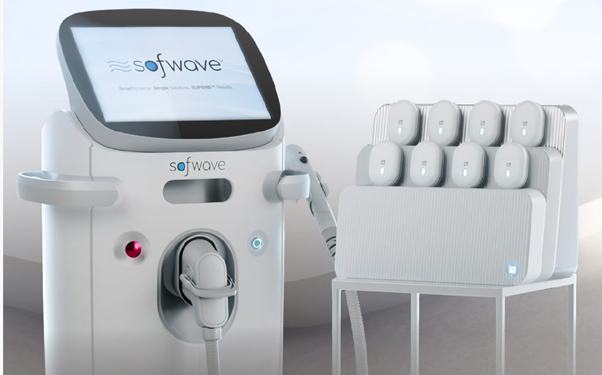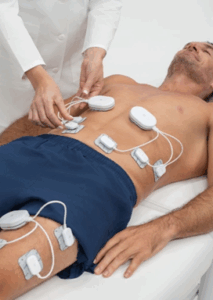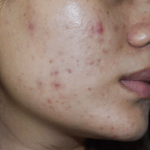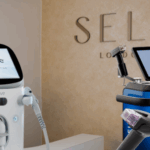
Losing weight can be one of the most positive and transformative changes you make for your health. Yet it is common to find that, as the body becomes lighter, the skin does not immediately match the new shape. Around the abdomen, arms, thighs or jawline, the skin can appear softer or less firm.
This is not a failure of effort or discipline, but rather, a biological response. The skin and the tissues beneath it remodel at different speeds, and when the deeper layers change more quickly than the surface, laxity can appear. Understanding why this happens allows you to support your skin intelligently through the process.
Why does the skin change during weight loss?
Skin is a living, adaptive organ composed of several layers. The outer epidermis provides protection. Beneath it, the dermis contains collagen and elastin fibres that give skin strength and flexibility. The deepest layer, known as the subcutaneous tissue, is made of fat, connective tissue and small blood vessels that anchor the skin to the underlying muscle.
The dermis behaves like a living scaffold. Collagen forms the framework, elastin gives it recoil, and water-binding molecules called glycosaminoglycans maintain firmness and hydration. These elements are constantly remodelled by fibroblasts, the cells responsible for producing collagen, elastin and extracellular matrix proteins.
When body fat increases, the dermal structure stretches to accommodate it. Collagen and elastin fibres reorganise to maintain this new configuration. When weight is lost, especially rapidly, the adipose layer beneath the skin shrinks before the collagen network can tighten again. The result is temporarily reduced tension and visible laxity.
Age compounds this process. The activity of cells known as fibroblasts slows, and the production of collagen and elastin declines. Oestrogen reduction and chronic oxidative stress also reduce the skin’s ability to synthesise glycosaminoglycans, which are essential for moisture and volume. The skin becomes thinner and less elastic, and its capacity to retract after weight loss decreases.
In some individuals, the use of GLP-1 medications such as semaglutide or tirzepatide accelerates these changes. These drugs promote fat loss but can also reduce lean muscle mass, depriving the skin of one of its most important sources of internal support.
The relationship between muscle and skin
Skeletal muscle is fundamental to how the skin behaves. It gives shape to the body, supports posture and provides the mechanical tension that keeps the skin smooth and firm. Each muscle contraction improves blood flow and lymphatic drainage, supplying oxygen and nutrients that fibroblasts require to function effectively.
When muscle mass declines during weight loss, the skin loses part of its supporting framework. The surface then appears looser, not because the skin itself has failed, but because the internal foundation has diminished. Maintaining or rebuilding muscle mass is therefore essential not only for strength and metabolism but also for the skin’s structural integrity.
Building internal support with Pure Impact

Pure Impact uses electromagnetic stimulation to contract muscles at a level that goes beyond what is achievable during voluntary exercise. Each session triggers thousands of intense contractions, activating a greater proportion of muscle fibres. These contractions cause the fibres to enlarge and strengthen, increasing muscle density and tone.
From a physiological perspective, this process enhances the mechanical load transmitted to the dermis, a key factor in stimulating fibroblast activity. The improved circulation that follows supports oxygenation and nutrient delivery to the skin. For patients losing weight, Pure Impact helps maintain lean mass, preserve body contour and minimise the appearance of laxity by rebuilding the structure beneath the skin.
Collagen renewal and skin elasticity
The skin’s firmness depends on the balance between collagen breakdown and renewal. Collagen is made up of tightly coiled triple-helix structures that provide tensile strength, while elastin allows the skin to return to its original shape after stretching. Fibroblasts continually remodel these fibres, but their activity declines with age and stress.
To encourage new collagen formation, the dermis must be stimulated to initiate controlled repair. This occurs when the tissue reaches a specific thermal threshold, activating fibroblasts and triggering the release of growth factors such as transforming growth factor beta (TGF-β). These molecules signal the synthesis of fresh collagen and elastin. Over the following months, the dermis becomes thicker, stronger and more elastic.
How Sofwave stimulates collagen regeneration
Sofwave delivers focused ultrasound energy to a uniform depth of about 1.5 millimetres beneath the skin, targeting the mid-dermis where most collagen fibres are found. The energy gently heats the tissue to an optimal temperature that causes existing collagen to contract while stimulating fibroblasts to produce new collagen and elastin.
This process creates controlled zones of thermal repair without affecting the surface. The skin gradually becomes firmer as new fibres develop and reorganise. Because the energy acts independently of pigment, Sofwave is suitable for all skin types. Clinical research has shown measurable improvements in skin elasticity, thickness and lift within three months, with continued improvement as collagen matures over time.
Sofwave can be used on the face, neck, jawline, abdomen, arms and thighs, all areas prone to laxity following weight loss. It works particularly well when skin has thinned but not completely lost elasticity.
Why combining muscle and skin treatments is most effective
The muscle, fascia and skin form a single biomechanical system. Treating one element without the others produces limited improvement. Pure Impact strengthens and thickens muscle, restoring the foundation beneath the skin. Sofwave reinforces the dermis by rebuilding its collagen network.
When used together, these treatments restore both tension and texture. The muscle provides structural lift and support, while collagen remodelling tightens the surface. This combination allows the skin to adapt more naturally to changes in body composition, creating smoother, firmer contours that align with the body’s new proportions.
Supporting tissue health from within
Technology works best when combined with strong nutritional and metabolic support. Collagen and muscle require adequate protein intake, as amino acids such as glycine, proline and lysine form the building blocks for both tissues. Vitamin C, zinc and copper are essential for collagen cross-linking, and omega-3 fatty acids reduce inflammation that can degrade the dermal matrix.
Hydration plays a crucial role. The skin’s extracellular matrix relies on water-binding molecules to maintain flexibility and pressure. Dehydrated skin becomes more fragile and less responsive to stimulation. A gradual, balanced approach to weight loss allows fibroblasts and muscle fibres time to remodel, ensuring changes occur evenly across all layers of tissue.
The importance of clinical expertise
Energy-based devices depend on precise control of energy depth, duration and thermal dose. Achieving consistent, safe outcomes requires a thorough understanding of anatomy, tissue behaviour and thermodynamics. In experienced medical hands, treatments such as Pure Impact and Sofwave can be calibrated to the individual’s skin type, age, rate of weight loss and baseline muscle tone. This approach ensures effective collagen stimulation without risk of overheating or inflammation.
The takeaway
Loose skin after weight loss is not inevitable. It reflects the time needed for the skin’s collagen, elastin and muscle systems to remodel. When these are supported through targeted stimulation, nutrition and gradual progress, the skin can contract and renew alongside the body’s transformation.
Pure Impact and Sofwave work at different levels to strengthen the structures that keep skin firm, one rebuilding the muscle foundation, the other regenerating collagen. Together, they help the skin remain resilient, supported and in harmony with a changing body.
If you’d like to explore treatments for loose skin, contact our Harley Street dermatology clinic where our skin experts can provide guidance for the best treatments for you.





